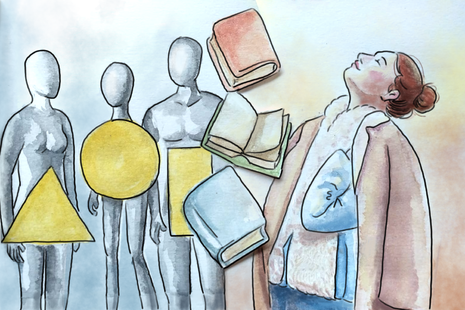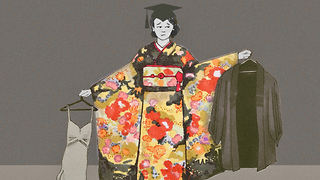Accessorise your outfit with … a book?
Mary Anna Im, in conversation with fashion podcaster Avery Trufelman, examines the trend of books as fashion accessories and the rise of performative reading

Forget handbags or sunglasses. There’s a new fashion accessory this year. (No, not Labubu dolls.) The latest and chicest fashion accessory is the book.
But not any book can function as an accessory. Fashion accessories are, by definition, an item or article that complements an outfit, used to enhance a look or make a statement. Therefore, for a book to function as an accessory, there are two prerequisites: first, the book must have its own aesthetic value; second, the outfit itself must also be fashionable.
We choose more conventional fashion accessories like handbags, hats, or sunglasses based on certain criteria: the visual appeal of the item; whether the brand evokes an emotion or signals a certain status; or whether it enhances an outfit. Perhaps the criteria a book has to meet to function as a fashion accessory are roughly this: Is the cover aesthetic? Is the book niche enough to ensure you won’t be perceived as unoriginal? And does the content or author of the book signal you are politically aware or culturally knowledgeable?
We’ve seen this taken to the extreme recently. Matcha latte, wired headphones (Clairo song likely being played), tote bag, and – most crucially – a book in hand. This is the uniform of what social media is calling the ‘performative reader’, usually a man pejoratively labelled as a ‘performative male’. A performative reader is someone who reads (or pretends to read) to suggest they are of a certain intellect, superior to the screen-watching majority. Their fashion accessory of choice is a paperback carried around like a handbag to demonstrate just how cultured they are.
“The performative reader is not just reading the book, they’re wearing it”
Sure, we can’t wear a book – but what if we can? The performative reader is not just reading the book, they’re wearing it: the book cover is complementary to the outfit, and through their choice of paperback – like all fashion choices – they are presenting a curated image of themselves. That is, a fashionable intellectual – an oxymoron to some.
Curious what someone immersed in the fashion sphere would make of books as accessories, I sought out the opinion of fashion podcaster Avery Trufelman, the host and producer of ‘Articles of Interest’. Trufelman’s podcast traces the history of what we wear and explores more abstract topics related to fashion like modesty and uniforms. Trufelman’s thorough research and lucid commentary is what makes ‘Articles of Interest’ stand out in the saturated podcast world – and in July 2025, TIME magazine included the podcast in its list of ‘The 100 Best Podcasts of All Time’.
“By choosing to display what you’re reading, like with all fashion choices, the decision is tied up with self-identity – what image of ourselves we are willing and want to showcase to the world”
When I asked Avery upfront if she thought a book could be considered a fashion accessory, without a second of hesitation she asserted, with no hesitation, “Definitely.” I anticipated she might have some resistance to books culturally transforming into something more superficial, but instead she admitted, “Part of me is like: sure, let’s just fetishise the book. Especially because the book as an object is entirely optional now.” Trufelman pointed out two reasons for the optional nature of reading – “Not only because one needn’t read, but also one could just use this thing!” At this point she whipped out her Kindle from thin air and held it up to the camera. By choosing to display what you’re reading, like with all fashion choices, the decision is tied up with self-identity – what image of ourselves we are willing and want to showcase to the world.
The overlap between books and fashion is an established one, Trufelman highlighted: “I think a lot about, you know, Olympia Le-Tan….” – the French designer who created the now iconic book clutch which comes in hundreds of cover designs from Tolstoy to Austen – “… and artists and designers who have made bags in the shape of books and things that play with the book form, because it’s such a pleasing form.” The ‘pleasing’ form Trufelman mentions here perhaps speaks to the enduring appeal of the physical book’s tactility.
“Even if a book is being read performatively, it’s still being read”
Our conversation drifted to the topic of what constitutes coolness in fashion currently, and the current fixation on appearing nonchalant. “Everyone’s too demure. No one wants to start conversations,” Trufelman lamented. In defence of the ‘too demure’ majority, Trufelman’s job as a podcaster and producer, which involves interviewing people regularly, does give her a boost in the conversation-opportunity department. But we agreed that seeing what someone is reading can be a great conversation starter – perhaps one major social advantage for the performative reader.
After our conversation ended, I was left with the sense that if books have become a fashion accessory or are being treated like one, there’s nothing wrong with that. Even if a book is being read ‘performatively’, it’s still being read. Creating a hierarchy of reading – with ‘authentic’ (whatever that means) at the top and ‘performative’ reading at the bottom – seems futile. And with fewer people than ever reading for pleasure, we shouldn’t’ discourage the activity any further by shaming readers, no matter if they’re cramming on the street before a supervision, or simply using the paperback as a means to enhance their outfit.
 Comment / Plastic pubs: the problem with Cambridge alehouses 5 January 2026
Comment / Plastic pubs: the problem with Cambridge alehouses 5 January 2026 News / Cambridge academics stand out in King’s 2026 Honours List2 January 2026
News / Cambridge academics stand out in King’s 2026 Honours List2 January 2026 News / Cambridge businesses concerned infrastructure delays will hurt growth5 January 2026
News / Cambridge businesses concerned infrastructure delays will hurt growth5 January 2026 News / AstraZeneca sues for £32 million over faulty construction at Cambridge Campus31 December 2025
News / AstraZeneca sues for £32 million over faulty construction at Cambridge Campus31 December 2025 Interviews / You don’t need to peak at Cambridge, says Robin Harding31 December 2025
Interviews / You don’t need to peak at Cambridge, says Robin Harding31 December 2025










